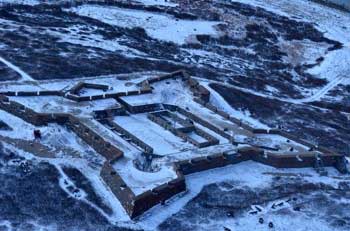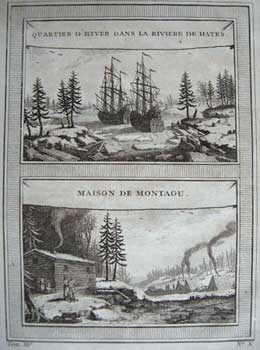
“Asleep by the frozen sea”
PROLOGUE ARTHUR DOBBS vs. MIDDLETON AND ‘THE COMPANY’
The argumentative, but influential, parliamentarian Arthur Dobbs, (see also Section 2) being dissatisfied with the result of Middleton’s 1741-2 expedition, organized this expedition in the ships Dobbs Galley (William Moor) & California (Francis Smith) ostensibly to broaden the trading outlets (monopolized by the Hudson’s Bay Company). But he also wished to expand the frontiers of British influence in the Hudson’s Bay area by further exploration for a Northwest passage, described by Henry Ellis in his book “Voyage to Hudson’s Bay” published 1748. Ellis was a hydrographer, surveyor and mineralogist. The expedition was instigated by the North-West Committee, a body of Dobbs’ supporters, in the years following Captain Christopher Middleton's abortive attempt to find a passage, and the subsequent acrimonious dispute between Dobbs and Middleton.
Claiming that Middleton's report was 'Fake News', Dobbs used it as a pretext to further his own political career and agenda which proved to be a successful political tool that eventually led to his appointment as Governor of N. Carolina. (A more recent would-be politician also effectively used 'Fake News' to advance his own career - and look where it got him!)
The expedition wintered on the southwest corner of Hudson’s Bay at Fort York /York Factory, Hayes River, (1746-7). Unsurprisingly they received a somewhat cool reception from the H.B.C. employees, before following the route of Middleton’s earlier expedition along the western shore re-exploring Wager Bay, which Moor hoped, would be the opening to the Pacific. After detailed reconnoitering in small boats it was found to be a closed inlet. Likewise, Chesterfield Inlet which after four days’ westward exploration was found to taper into shallow and fresh water, dashing further hope of a passage at those latitudes.
Dobbs’ expedition was an attempt to overthrow the monopoly of the Hudson's Bay Company, which one contemporary critic described in the following terms “The Company have for eighty years slept at the edge of a frozen sea …. They have shewn no curiosity to penetrate farther themselves, and have exerted all their art and power to crush that spirit in others.” Joseph Robson
The dispute between the protagonists was raised in Parliament (where a bill in 1745 failed to remove the H.B.C. trading monopoly) and in a long pamphlet war, reaching its climax in 1749. Eventually ‘The Company’ under increasing pressure was forced to release documents about its activities and face questions from a Parliamentary Committee which demolished the barrier of close secrecy behind which it had it hidden for so long. The Admiralty called upon Middleton to clear himself of Dobbs' accusations and explain his discoveries. The latter he did, but as to the former they considered Middleton culpable. The Admiralty then at Dobbs' instigation proposed that Parliament award a prize of £20,000 to the discoverer of a N-W.passage 'through Hudson's Bay' (1743 18 Geo. II)
Whilst the discovery ventures of the period, including this expedition, failed to reveal a Northwest Passage they did bring the area to public attention and provide survey material on a neglected area of the British Empire in North America. The stage was set for further exploration.
REFERENCES CITED:
Cumming W.P., Hillier S.E., Quinn D.B. Williams G. The Exploration of North America 1630-1776.
Sabin Bibliotheca Americana, A Dictionary of Books relating to America. New York, 1868-1936.
Wagner, H.R. the Cartography of North-West America to the year 1800. Berkley 1937
Cook, A., Holland, C. The Exploration of Northern Canada 500-1920 A chronology. Toronto 1978.
Barrow Sir J. A chronological history of voyages into the Arctic regions (1818) reprint 1971.





